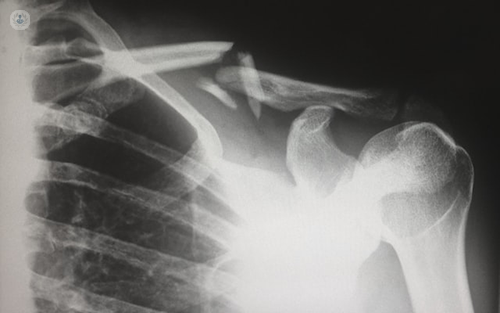Broken collarbone
Ms Susan Alexander - Orthopaedic surgery
Created on: 12-30-2015
Updated on: 05-23-2023
Edited by: Sophie Kennedy
What is a clavicle fracture?
A clavicle fracture affects the long, thin bone also known as the collarbone, which is located in the upper chest, between the sternum and the shoulder. Its function is to join the upper limbs with the thorax and keep the shoulders aligned. An injury that causes the clavicle to be broken can also cause the clavicle to be dislocated or the neighbouring acromioclavicular joint to dislocate.

What are the symptoms of a broken collarbone?
If the fracture is mild, the main symptoms are:
- pain in the fractured bone area
- a feeling that the shoulder could be dislocated
- difficulty and pain when moving the shoulder or arm
- bruising, swelling or a bulge in the clavicle
- crunching or creaking noise when lifting the arm
If the fracture is more severe you may notice:
- significant irregularity in the clavicle area
- lack of sensitivity or tingling sensation in the arm or the fingers of the hand
What can cause a broken collarbone?
A clavicle fracture is almost always caused by a violent impact on the arm extended in a fall or by a fall directly on the shoulder itself. It is more frequent in children, since these bones do not harden until adulthood.
When should you seek medical assistance about a broken collarbone?
If you think that you may have fractured your clavicle, you should visit a hospital as soon as possible to receive medical assistance. While waiting to see a doctor, using an ice pack and over the counter pain killers can help to alleviate any discomfort. Remember that children under the age of sixteen should not take aspirin.
Using a sling can also help to make the injury more comfortable while waiting for medical attention. If the injury is causing extreme pain or the injury is very severe, call the emergency services and ask for advice.
How is a broken collarbone diagnosed?
A clavicle fracture requires a physical examination and imaging tests. In the examination, the doctor will ask you how the injury occurred and will examine your shoulder to see if there are any irregularities. An X-ray can determine whether the clavicle has fractured and whether any other damage has taken place.

How is a broken collarbone treated?
In many cases, the clavicle can heal without surgical intervention. Treatment involves:
- medication to reduce pain and swelling
- keeping your arm supported in a sling
- exercises to gradually build up the mobility in your shoulder as it heals
It is important to see the doctor regularly for follow-up scans to check the clavicle is healing in the right way. If the bone does not heal correctly, a large bump can form over the clavicle, and this may take many years to subside.
When is surgery required for a broken collarbone?
Surgery is indicated in fractures that involve a displacement of the fractured bone. There are several surgical techniques, including the use of needles that are placed through the skin, the placement of plates screwed to the bone or the placement of a long screw inside the fractured bone.
After the procedure, the arm must be placed in a sling for at least a few days, and no daily activities or weight lifting can be carried out for four to six weeks.
How long does a broken collarbone take to heal?
Patients usually go back to the hospital’s outpatient department around a week or so after being discharged so a healthcare professional can check that the collarbone is healing as it should. If you are concerned about your injury after being discharged, the pain suddenly worsens or you feel weakness in your arm or hand, you should go back to the hospital’s Accident and Emergency department to seek urgent medical advice.
In adults, it may take between six and eight weeks for a broken collarbone to heal although in some patients, the healing process takes longer. For children, the recovery period is shorter, and usually takes around three to six weeks.
Although a broken collarbone can usually heal over a period of around two months, it can take doubly as long for the shoulder to regain its full strength. If the fracture is not healing with conservative (non-surgical) treatment, surgery may be necessary.
A number of measures can aid recovery from a broken collarbone, including:
- sleeping in a more upright position if uncomfortable in bed, using extra pillows as necessary
- using ice packs and pain killers to alleviate discomfort
- removing the sling for limited periods later in the recovery process, if the injury is not too painful to do so
- maintaining regular movement of the hand, fingers and elbow when you are able to do so
It’s important to avoid weight lifting and contact sports until at least three months after your injury. Follow your doctor’s advice on returning to work, driving and other daily activities.
What type of doctor treats a broken collarbone?
Orthopaedic surgeons and sports medicine specialists treat broken collarbones.
